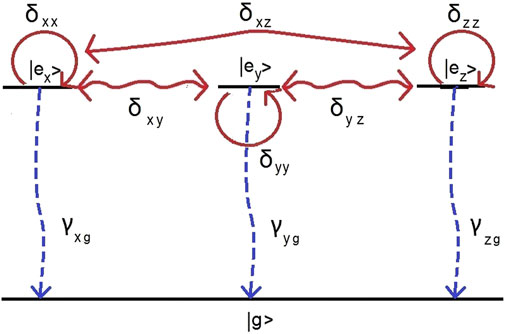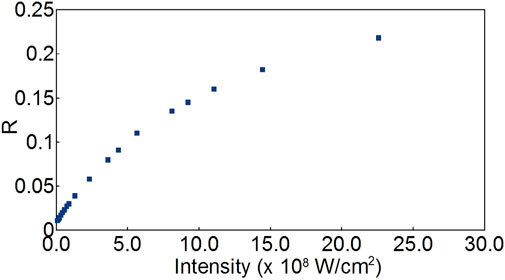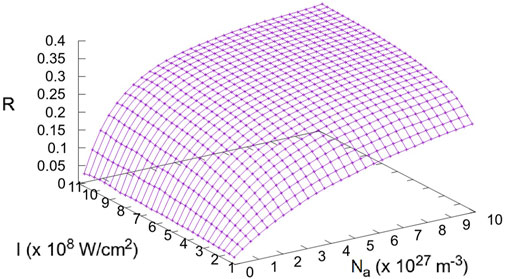- 1Department of Natural Sciences, Northwest Missouri State University, Maryville, MO, United States
- 2Department of Physics, University of Windsor, Windsor, ON, Canada
We present a theoretical model for a class of optical scattering experiments in which short-duration, linearly-polarized electromagnetic pulses scatter off dielectric liquids. The pattern of scattering, particularly in the transverse direction, indicates that significant free currents are generated in the direction orthogonal to the polarization of the incident light. Modelling the target as a dense cluster of two-level systems, we show that transverse free currents are produced by short duration, electric-dipole interactions between proximate molecules, and result in scattering patterns similar to those observed in the experiments. Calculations provide a rationale for why these scattering patterns are not observed in the same molecules at lower densities or with lower field intensities. These features make this model a relevant alternative to proposed transverse optical magnetism theories.
1 Introduction
Optical or artificial magnetism is typically seen in specifically-engineered, nanofabricated metamaterials such as thin metallic strip pairs [1], split-ring resonators [2], and hyperbolic metamaterials [3]. As the name metamaterial implies, these devices are specifically engineered to have properties beyond those traditionally found in naturally-occuring materials, and typically contain nanostructures with precise geometries. Over the last decade, a series of experiments [4–7] have reported observing optical magnetism in dielectric liquids. These experiments have generated significant interest due to the prospect of observing magneto-optic interactions in naturally-occurring, non-magnetic materials [8]. These experiments, in which a dielectric liquid (such as water or carbon tetrachloride) is excited by a short-duration (
In this paper, we present an alternate theoretical model that can explain the experimental observations in Refs. [4–7] by including inter-molecular effects. In this model, strong, transverse free currents are produced through inter-molecular electric-dipole interactions without invoking magneto-optic effects in single molecules. Because the strength of inter-particle interactions decreases directly as the density of emitters decreases, this model can explain experiments in which scattering effects exhibit a strong density dependence. For example, it explains why these intensity patterns are not observed in scattering experiments that use low molecular density phases (such as the gas phase) [17].
2 Theoretical Model and Calculations
When a linearly-polarized electromagnetic pulse is incident on a dense ensemble of molecules, the light absorbed by an individual molecule creates a free current in the initial polarization direction. Upon spontaneous emission, this light is re-emitted in a well-known dipole pattern. In a dense medium, this light is reabsorbed by neighboring molecules located at different spatial positions. This subsequent absorption by neighboring molecules leads to a free current that is not necessarily in the same direction as the incident polarization direction. By exciting radiating dipoles perpendicular to the polarization of the incident field, the ensemble will emit photons in multiple polarization directions. This creates radiation patterns similar to those observed in the experiments.
In our calculations, we model the scattering of a strong, electromagnetic pulse by the target molecular liquid in the experiments by a single-particle model of a dense, driven ensemble of quantum dipoles (two-level systems) [18]. We assume that the incident electromagnetic pulse is near-resonant with a single optical transition in the molecule. Since the quantum dipoles are excited by the local electromagnetic field, the excitation direction of each dipole can be different from each other and from the initial polarization of the incident electromagnetic field. To model excitations in directions other than the incident polarization direction, the state of the ensemble is represented by the density matrix of a four-level quantum system with one ground energy level
The Hamiltonian of the ensemble of two-level molecules, after making the rotating wave approximation as in Ref. [18] is:
where
In our four-level model, the spontaneous emission from the
The magnitude of these dephasing rates associated with energy transfer between molecules (
where
The term
A diagram of all the decoherence processes in the single-particle quantum model of the ensemble is provided in Figure 1. The Lindblad superoperator representing the spontaneous emission, and dephasing due to intermolecular energy transfer has the form:

FIGURE 1. Decoherence structure in a single-particle approximation of a driven molecular ensemble. Inter-molecular energy transfer due to reabsorption of spontaneously emitted photons (
with
The density matrix of the ensemble,
As shown in Ref. [18], the time-dependent behavior of the density matrix of an ensemble in a four-level basis, agrees very well with the numerically calculated, average time-dependent behavior of
After calculating the time-dependent density matrix elements, we determine the Emission Ratio (R), the ratio of the intensity perpendicular the incident polarization (called
This ratio can be expressed in terms of the ensemble density matrix elements since
which yields a simple relationship between calculated elements of the ensemble density matrix, and the measured Emission Ratio. We assume that the transition dipole moments are the same in each direction,
This model is sensitive to both the density of molecules in the ensemble as well as the intensity of the applied field. Under low intensities or low densities these inter-molecular effects are not significant. Over long time periods, these effects die out very quickly. However at high intensities, high densities and short time periods these effects can lead to significant excitation and free currents generated in orthogonal polarization directions [18]. This is similar to experiments in coherent atomic ensembles that have shown that inter-atomic interactions affect resonance frequencies and scattering polarizations, in a way that is dependent on both the density of emitters and the incident intensity [21].
3 Emission Ratios From a Dense Ensemble
We now calculate the Emission Ratio R generated in response to a strong incident pulse similar to the experiments in Refs. [5, 6]. A 100fs pulse with an intensity of
Figure 2 shows the dependence of the emission ratio for water on the intensity of the applied 100fs pulse. The range of pulse intensities was chosen to match the overall range found in the experiments in Refs. [5, 6].

FIGURE 2. Emission Ratio of water as a function of increasing intensity of the applied 100fs pulse. As the intensity increases, the transition to the excited state of each molecule is driven more strongly, and the probability of inter-molecular energy transfer increases, thus increasing the Emission Ratio.
From this figure, it is seen that for the emission ratio to become significant for 100fs pulses, the average field intensity needs to be higher than
This quantitative difference is not surprising as our model treats the molecules as dipole emitters and looks at no other interactions between molecules. However, given the generality of our model and the fact that the Emission Ratio under this mechanism is similar in strength to what is measured, it suggests that this alternate pathway from transverse free currents and scattered intensities should represent a significant step in understanding short-pulse scattering experiments from dielectric liquids.
In addition to intensity-dependent effects, our model also predicts that there should be a strong dependence on the density of the medium. This dependence is an attractive feature of this alternate model as strong transverse free currents are typically not seen in gas-phase scattering experiments [17].
Using our simplified model, Figure 3 shows the predicted density dependence of the Emission Ratio of a general molecular ensemble with electric dipole transition moment around

FIGURE 3. Density dependence of the Emission Ratio of an ensemble of molecules with electric dipole transition moment
Due to the presence of this density dependence, we suggest two possible experiments that could validate our model. The first involves performing the same experiments as described in Refs. [4–7] by using systems with varying molecular densities. If the transverse free currents are caused by inter-molecular electric interactions, the Emission Ratio should clearly increase as a function of density (whereas a single-molecule magneto-optic effect will not be effected by density). This may be accomplished by performing these short-pulse scattering experiments on the same liquids at different temperatures and pressures. The second suggested experiment is a measurement of the time-dependence of the scattered signal. Since out model involves absorption and re-emission between molecules, it is naturally time-dependent and thus the Emission Ratio should change as a function of time, and also be fairly sensitive to different pulse widths at the same intensity.
4 Conclusion
For optical scattering experiments in dense media, the interactions between molecules can have a significant effect on the observed scattering intensity patterns. We have proposed a theoretical model wherein significant transverse currents are generated in optical scattering experiments on dielectric liquids due to inter-molecular electric-dipole interactions. Using our model, we show that the strength of these inter-molecular interactions increase with both density and incident intensity. The calculated dependence of the transverse currents on the intensity of the incident electromagnetic pulse agrees with experimental results. The density dependence provides a direct explanation for why these effects do not appear in scattering experiments involving less-dense targets such as gases. We provide suggestions for future scattering experiments that can validate our model.
Data Availability Statement
The raw data supporting the conclusions of this article will be made available by the authors, without undue reservation.
Author Contributions
CD performed the calculations, interpreted the results and co-wrote the manuscript. CR oversaw the project, advised CD, assisted in the analysis, and co-wrote the paper.
Funding
CD greatly acknowledges computing resources made available through the National Science Foundation under Grant No. 1624416. CR gratefully acknowledges support from the Discovery Grant program of the Natural Sciences and Engineering Research Council of Canada (funding reference number RGPIN-2019-06387).
Conflict of Interest
The authors declare that the research was conducted in the absence of any commercial or financial relationships that could be construed as a potential conflict of interest.
References
1. Chettiar UK, Kildishev AV, Klar TA, Shalaev VM. Negative index Metamaterial Combining Magnetic Resonators with Metal Films. Opt Express (2006) 14:7872. doi:10.1364/oe.14.007872
2. Zhou J, Koschny T, Kafesaki M, Economou EN, Pendry JB, Soukoulis CM. Saturation of the Magnetic Response of Split-Ring Resonators at Optical Frequencies. Phys Rev Lett (2005) 95:223902. doi:10.1103/physrevlett.95.223902
3. Poddubny A, Iorsh I, Belov P, Kivshar Y. Hyperbolic Metamaterials. Nat Photon (2013) 7:948–57. doi:10.1038/nphoton.2013.243
4. Oliveira SL, Rand SC. Intense Nonlinear Magnetic Dipole Radiation at Optical Frequencies: Molecular Scattering in a Dielectric Liquid. Phys Rev Lett (2007) 98. doi:10.1103/PhysRevLett.98.093901
5. Rand SC, Fisher WM, Oliveira SL. Optically Induced Magnetization in Homogeneous, Undoped Dielectric media. J Opt Soc Am B (2008) 25:1106. doi:10.1364/josab.25.001106
6. Fisher WM, Rand SC. Dependence of Optically Induced Magnetism on Molecular Electronic Structure. In: international Conference on Luminescence and Optical Spectroscopy of Condensed Matter (ICL’08); JUL 07-11, 2008, 129. Lyon, France: Univ Lumiere Lyon 2 (2009). p. 1407–9. doi:10.1016/j.jlumin.2009.02.036J Lumin
7. Fisher AA, Dreyer EFC, Chakrabarty A, Rand SC. Optical Magnetization, Part I: Experiments on Radiant Optical Magnetization in Solids. Opt Express (2016) 24:26055. doi:10.1364/oe.24.026055
8. Papadakis GT, Fleischman D, Davoyan A, Yeh P, Atwater HA. Optical Magnetism in Planar Metamaterial Heterostructures. Nat Commun (2018) 9:296. doi:10.1038/s41467-017-02589-8
9. Rand SC. Quantum Theory of Coherent Transverse Optical Magnetism. J Opt Soc Am B (2009) 26:B120. doi:10.1364/josab.26.00b120
10. Fisher WM, Rand SC. Light-induced Dynamics in the Lorentz Oscillator Model with Magnetic Forces. Phys Rev A (2010) 82:013802. doi:10.1103/physreva.82.013802
11. Fisher AA, Cloos EF, Fisher WM, Rand SC. Dynamic Symmetry-Breaking in a Simple Quantum Model of Magneto-Electric Rectification, Optical Magnetization, and Harmonic Generation. Opt Express (2014) 22:2910. doi:10.1364/oe.22.002910
12. Fisher AA, Dreyer EFC, Chakrabarty A, Rand SC. Optical Magnetization, Part II: Theory of Induced Optical Magnetism. Opt Express (2016) 24:26064. doi:10.1364/oe.24.026064
13. Palffy-Muhoray P. Comment on "Intense Nonlinear Magnetic Dipole Radiation at Optical Frequencies: Molecular Scattering in a Dielectric Liquid". Phys Rev Lett (2007) 99:189401. doi:10.1103/physrevlett.99.189401
14. Oliveira SL, Rand SC. Oliveira and Rand Reply:. Phys Rev Lett (2007) 99:189402. doi:10.1103/physrevlett.99.189402
16. Oliveira SL, Rand SC. Oliveira and Rand Reply:. Phys Rev Lett (2009) 102:119404. doi:10.1103/physrevlett.102.119404
17. Murphy WF. The Rayleigh Depolarization Ratio and Rotational Raman Spectrum of Water Vapor and the Polarizability Components for the Water Molecule. J Chem Phys (1977) 67:5877–82. doi:10.1063/1.434794
18. DiLoreto CS, Rangan C. Single-particle Model of a Strongly Driven, Dense, Nanoscale Quantum Ensemble. Phys Rev A (2018) 97:013812. doi:10.1103/physreva.97.013812
19. Fratalocchi A, Conti C, Ruocco G. Three-dimensional Ab Initio Investigation of Light-Matter Interaction in Mie Lasers. Phys Rev A (2008) 78:013806. doi:10.1103/physreva.78.013806
20. Novotny L, Hecht B. “emph “Bibinfo Title Principles of Nano-Optics, 8. Cambridge University Press (2006).
21. Bromley SL, Zhu B, Bishof M, Zhang X, Bothwell T, Schachenmayer J, et al. Collective Atomic Scattering and Motional Effects in a Dense Coherent Medium. Nat Commun (2016) 7:11039. doi:10.1038/ncomms11039
22. Tannor DJ. Introduction to Quantum Mechanics: A Time-dependent Perspective. Mill Valley, CA: University Science Books (2007).
23. Lovas FJ. Microwave Spectral Tables II. Triatomic Molecules. J Phys Chem Reference Data (1978) 7:1445–750. doi:10.1063/1.555588
Keywords: femtosecond pulse scattering, inter-molecular interactions, transverse scattering, lindblad master equation, ensemble scattering
Citation: DiLoreto CS and Rangan C (2021) Decoherent Excitation of Transverse Free Currents in Dielectric Liquids via Inter-Molecular Interactions. Front. Phys. 9:700283. doi: 10.3389/fphy.2021.700283
Received: 25 April 2021; Accepted: 28 June 2021;
Published: 14 July 2021.
Edited by:
Robert Gordon, University of Illinois at Chicago, United StatesReviewed by:
Huiqin Zhang, University of Pennsylvania, United StatesVladimir Malinovsky, United States Army Research Laboratory, United States
Copyright © 2021 DiLoreto and Rangan. This is an open-access article distributed under the terms of the Creative Commons Attribution License (CC BY). The use, distribution or reproduction in other forums is permitted, provided the original author(s) and the copyright owner(s) are credited and that the original publication in this journal is cited, in accordance with accepted academic practice. No use, distribution or reproduction is permitted which does not comply with these terms.
*Correspondence: C. Rangan, cmFuZ2FuQHV3aW5kc29yLmNh
 C. S. DiLoreto
C. S. DiLoreto C. Rangan
C. Rangan